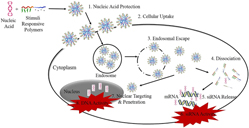Article contents
Stimuli responsive polymer-based strategies for polynucleotide delivery
Published online by Cambridge University Press: 24 April 2017
Abstract

In recent years, stimuli responsive polymer based gene delivery vehicle design for cancer treatment and treatment of other genetic disorders has received extensive attention. Early studies focusing on DNA delivery have been facilitated by functional polymers and this area has seen further growth spurred by recent gene silencing strategies developed for small RNA [i.e., small interfering RNA (siRNA) or micro RNA (miRNA)] delivery. DNA and small RNAs possess analogous properties; however, their explicit differences define the specific challenges associated with the delivery route and the design of functional materials to overcome distinct challenges. Apart from classical gene delivery, the recent advances in genome editing have revealed the necessity of new delivery devices for genome editing tools. A system involving CRISPR (clustered, regularly interspaced, short palindromic repeats) and an endonuclease CRISPR-associated protein 9 (Cas9) coupled with a short, single-guide RNA (sgRNA) has emerged as a promising tool for genome editing along with functional delivery systems. For all these nucleic acid based treatments, the internal or external physiochemical changes in the biological tissue/cells play a major role in the design of stimuli responsive delivery materials for both in vitro and in vivo applications. This review emphasizes the recent advances in the use of pH, temperature, and redox potential-responsive polymers overcoming hurdles for delivery of gene and gene editing tools for both in vitro and in vivo applications. Specifically the chapter focuses on recently proposed delivery strategies, types of delivery systems, and polymer synthesis/modification methods. The recent advances in CRISPR/Cas9-sgRNA technology and delivery are also described in a separate section. The review ends with current clinical trials, concluding remarks, and future perspectives.
- Type
- Invited Reviews
- Information
- Journal of Materials Research , Volume 32 , Issue 15: Focus Issue: Two-Dimensional Nanomaterials for Biosensors , 14 August 2017 , pp. 2930 - 2953
- Copyright
- Copyright © Materials Research Society 2017
Footnotes
Contributing Editor: Venkatesan Renugopalakrishnan
This section of Journal of Materials Research is reserved for papers that are reviews of literature in a given area.
References
REFERENCES
- 11
- Cited by



